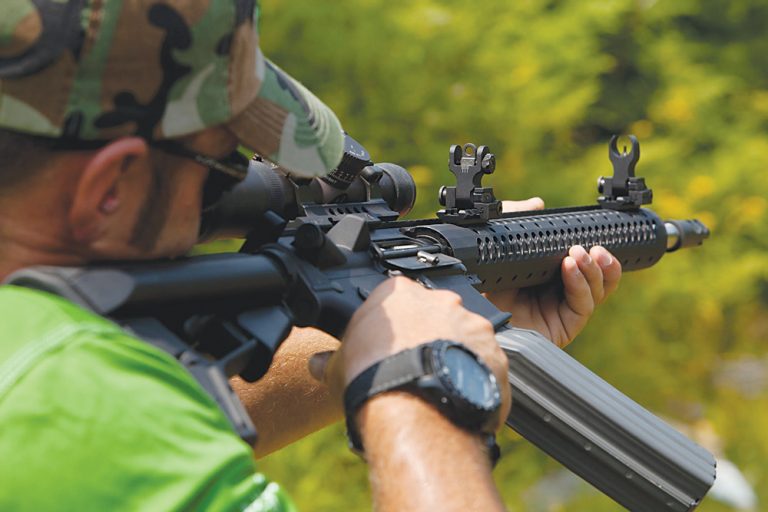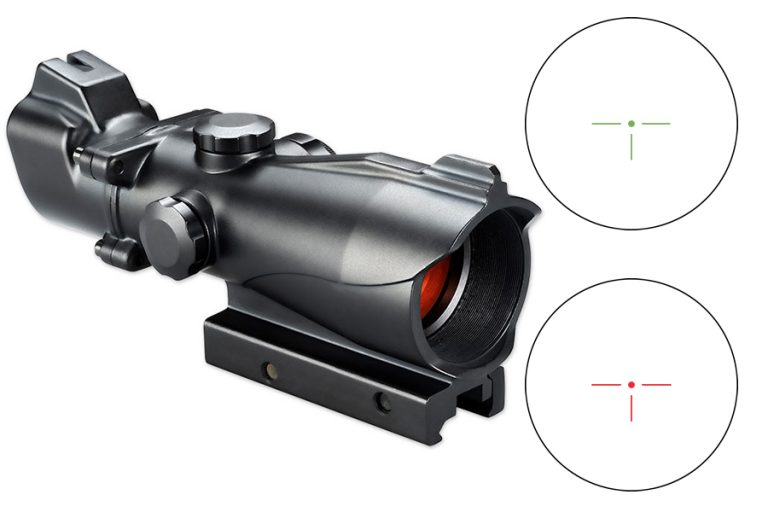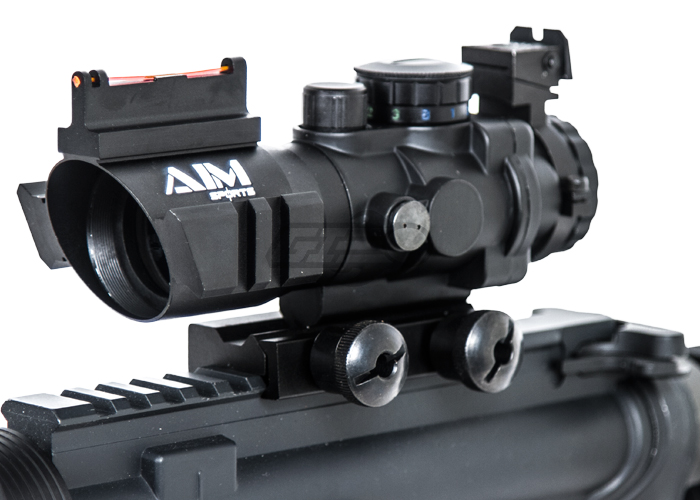
Let me start by saying this: I am not a fan of hanging fifty-million things and a coffee maker from my AR or upgrading a $200 10/22 with $1K worth of furniture. It’s just not my style and I’m of the mentality that the more things any item has, the more things there are to snag and break. Especially when I’m looking at firearms for home- or self-defense or hunting, I want to eliminate potential disasters.
That said, there are a few things on the market that I and some of my partners and buddies now have, but we don’t really see often on the ranges, blogs, or forums. I consider some of them game changers. So today, I’m going to point out offset sights, optics with integrated sights, and a specific type of single-point sling adaptor that could change some minds about the best gadgets for your guns.
*The links are only examples. There are others available. Please shop around and find additional reviews and pricing options.
Offset Sights
Offset sights like these are intended to be used in conjunction with an optic or scope.
Quickie refresher: Scope – dedicated crosshair aiming aid, adjustable or fixed magnification using lens refraction (no battery for many/most); Optics – either all lens-based aiming assistants; or battery-powered light-up aiming aids, regularly with multiple types and-or colors of dots and open- or closed-ring reticules to choose from and additional choices like red dot versus holographic. I’ll use the more disparate definitions this go-round.
In some cases, offset sights allow a shooter to switch between a longer-range target appropriate for a medium- to high-magnification optic or scope, and a close-quarters target by simply tilting the firearm a bit. In other cases, they allow a shooter to have a backup sighting option in case their optic has a really bad day at a really bad time (dead batteries, solid smack, cracked lens, blowing snow, sprayed mud).
They’re also useful as a way to avoid switching between optic types or colors that perform better in varying light and background conditions, although that crops up more regularly with competition and smaller game shooting.
Co-witnessing standard iron sights and optics or scopes is certainly an option. There’s a little fiddling at times to get height right, but an MBUS rear sight is hardy and fast to pop up even in freezing weather and gloves or sweltering summers with slippery hands, and you learn to let the front sight blur in front of your crosshairs or optics just like you learn to switch between a front sight focus and target focus when you hunt with a pistol and a bead-sight shotgun. Still, I really like the ease of just tilting a firearm.
Up to a .223/5.56, anyway.
AR-10’s, SOCOM .308’s, and the other 7.– platforms are a little more than I can comfortably handle for more than a couple of shots tilted, even being 6’ in heels and 200# in winter gear. It’s also harder for me to keep the firearm under control when it’s angled with larger calibers. That’s where the second nugget comes in.
Optics with Integrated Iron Sights
Manufacturers of optics with integrated iron sights like the Bushnell AR Optics 1x MP Illuminated Red/Green T-Dot Reticle Riflescope or the Aim Sports 4X32 Tri III. Scope with Fiber Optic Sight seem like they have missed a really, really big advertising and searchable description point to me. I had never heard of having more than a blade front sight centered on an optic or scope until fairly recently. The ability to actually adjust an iron sight as a backup to a scope is huge for me, and having it all be in one single piece without the need for extended or additional rails or attachments totally blew me away. You’d think they’d be singing from the hilltops about what they did. Instead, our groups see them very rarely and they tend to be unknown when people notice us using them at ranges.
I have the Bushnell for several guns, but its irons aren’t adjustable. Aim Sport apparently started manufacturing some of its models in the U.S. and fixing some of the import and manufactured-for-domestic-assembly products recently, so we jumped on a couple because they do allow us to adjust both the optic and the irons.
We’re pretty happy with the Aim Sports in the households that went there, but nobody’s had them much more than a year and I tend to want a little more history or a standing reputation for quality before I’m willing to give an unqualified recommendation. Mine holds both optic and iron-sights settings well in hard-times practice, banging around in a pickup bed in transit, and at 3-Gun and 100-yard Modern Sporter competitions. It’s not so hot as a shoulder-holstered or chest-carrier handgun optic. The Bushnell is a reasonable hunting handgun optic, although finding a holster for it is funtastic and I still have point-of-aim adjustments for certain rounds.
The joy with these is that while you do loose cheekweld, it’s not a tremendous adjustment, and you can still keep a firearm shouldered squarely. Too, with little to no movement of the gun, it gains a bit of speed. There are times when fractions of heartbeats matter, a lot.
As with the offset irons, the AimSport with adjustable iron sights can also be set up with one for <10-25 yards and one for 100-200+ yards. Another bonus is allowing me to shoot ammunition that performs very differently due to powder loads or specific projectile weight or shape easier. Instead of painter’s tape marked with point of aim differences on the firearm, I can set up a single optic for the two most common sets.
Buying fancy optics & irons
It’s not a totally inexpensive investment, but considering what we seem willing to pay for optics as a general shooting crowd, they’re not unreasonable. There is at least one other dual-sight optic manufacturer out there – possibly more, since they seem to be totally dropping the ball on marketing these puppies as a be-all solution for backups, lighting, evil match designer, or variable distances. Again, research is our friend.
Single-Point Sling Adaptor
I found a single-point sling adaptor with the intention of using it just for 10/22’s and airguns for practice. Then I decided it was fan-tab as a lanyard adaptor for a couple of my hunting or creak in the night handguns. And then we started testing some buckle varieties (which we mostly like better than the Velcro).
We’re pretty pleased.
I now have these or similar on a fair number of firearms. Don’t run them through a trigger guard or anything crazy like that, but most guns have somewhere they can get snugged. *We have yet to find one that works with M16A1 or A2 stocks; they block the charging handles. Skeleton or adjustable stocks only.
The straps do loosen up here and there as you go along, but a loaded Benelli Nova has been hanging from an unused belt (ahem, “sling”) with extra rounds in an attached purse (ahem, “ready bag”) behind a closet door for a couple of years. It’s been tightened maybe 4-8 times in its life now, and we’re talking about the gun that gets to go to the range and practice being a master key and LTL to lethal crowd and varmint control, then get dropped for a handgun for clearing and precision work. I use the same adapter on my 3-Gun shotgun and rifle.
It rolls around some, but I don’t consider the rolling to really be a bad thing, either. I live with and practice with a couple of lefties. It’s not a big deal in gloves, but for the ones who don’t practice “adaptably” as much as some of us, the buckle can be distracting and having to clip a sling to their shooting hand side is sometimes problematic. In a situation where they need to transition, a stock hanging up in the sling because it’s on a dedicated ring to one side can cost some precious heartbeats. The universal bands slip enough to eliminate that problem for us.
The other joy is that these things are $5-10, and require no tools or skill to install. Zero – an otter could do it. That means that while some do live with a sling attached, I can afford to put them on absolutely anything that might ever be grabbed in a hurry or needed in a defensive situation.
Now, instead of having dedicated rigs to account for various chest and height measurements from 24” and 5’6” up to 52” and 6’4”, everybody has a sling with their grab gear. They can then exchange firearms or grab whichever firearm is most appropriate for a situation, clip it, and roll. With person-specific slings instead of slings dedicated to firearms, a big, tall shooter doesn’t end up with a necklace or snagged as they “swim” into a sling, and a shorty doesn’t end up dragging even an 18.5” barrel’s front sight over the gravel and through the grass (both make it harder to shoot accurately; the latter may cause shouting from the gun owner during practice).

Slings (and sling clips) are one of those things I don’t see on firearms as often as I really should at the range. Being able to sling a firearm can be pretty invaluable. My household and partners like single-point slings best for defense (single-point slings are not really ideal for hunting – just saying). There are worlds’ worth of slings and adaptors out there, and they merit some research and a decent investment. There’s absolutely nothing wrong with picking up a sturdy 48” or 52” belt at Goodwill for $2 and a $2 clip at ACE to go with a $7 adaptor until you’re ready for that investment.
As mentioned, the really nice thing about those buckle-on single-point sling adaptors is that they’re so inexpensive, and adaptable to so many different types of firearms. Saving money on a sling and clip may let us get in some practice that makes us more effective or – over a household – might save enough money to invest in some solar-powered motion-activated lights that let us immediately locate an intruder of either the coyote or human type. That’s pretty invaluable, too.
How much should you spend on gadgets?
There are lots of tools and gadgets that make our lives easier or drastically increase our effectiveness and efficiency, but as with anything else, prioritize purchases. Make a list of goals, needs, the things that are most likely to strike personally and locally or regionally, and what’s already in the toolbox and junk drawer. Be creative as you look around, and visualize things that are already in-house as blank slates that can be adapted to other uses. A $15 lunch bag or laptop bag works just as well as a $25-75 range bag.
If something else works for now, until you’re better set, use that.
Do buy quality products when it’s something like a defensive firearm or its furniture (or smoke detector). That doesn’t mean you have to pay more for a manufacturer’s label and advertising costs. When it’s a $1K-$2800 HK versus a $500-700 S&W AR, get a S&W. It does mean that if something’s built for airsoft or paintball or costumes, you might want to consider the weights and abuse limitations. It’s usually worth it to spend more on something sturdier.
With the reminder that I’m just not big on hanging fifty million things from my firearm, there are a few choice gadgets that make a big difference and are worth some investment. A universal sling adaptor and the ability to engage targets accurately at multiple distances or if an optic craps out are two of the things that make my list. Hopefully even if they don’t make yours, something in this article gave you something to think about.
























